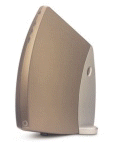I have a wireless network segment at home using the Lucent RG-1000 residential gateway. The RG-1000 has been passed around from WaveLAN to Proxim to Lucent to Avaya to Agere and back to Proxim, and so finding documentation and drivers can be a problem. Here are my notes, should anyone else be looking for information about this little router/gateway/access point.
The documentation that came with the gateway covered little more than running the basic setup, and didn’t cover important issues like how to reset the firmware, how to configure the firewall, how to limit access to the RG by MAC address and so on. I was able to learn more about the router on the web, and programs. The routers are quite popular, and googling “RG-1000” came up with a lot of hits.
1. Finding drivers is a little complicated. Proxim originally sold the router and card as a part of the WaveLAN line. Lucent either bought the line or Proxim and re-named it Orinoco. Lucent then spun off the company to become Agere and/or Avaya. Proxim re-appeared somewhere along the line, and now has drivers available at http://www.proxim.com. Because of this lineage, finding the right driver is difficult. I’m using the card drivers from http://www.proxim.com, the basic setup utility from http://www.avaya.com and the AP configuration utility from http://www.agere.com.
2. The Lucent/Orinoco RG-1000 is a residential gateway with bridging mode, full NAT router mode, and has a feature-set resembling many appliance routers. The Avaya RG-1 appears to be a re-branded RG-1000, and may have an ethernet port. The AP-500/1000 is an access point without the NAT router features and with more advanced bridging reporting/diagnostics. The Apple Airport resembles the RG-1000/RG-1. Oddly enough, the firmware is interchangeable between all the models, so you can convert a bridging only AP-500/1000 into a RG-1/RG-1000 by uploading a different firmware set.
The model I own has no ethernet ports, making it a little useless as a router if you have wired machines. It does have a V.90 modem, and can be configured as a dial-on-demand router. I’m going to use my PPP account as a dial backup.
3. There are two “official” configuration utilities – the RG setup tool, which is basic and lacks several important configuration tools, like MAC address security. The other utility is the Access Point configuration tool, which despite the name, can configure any of the compatible models. Once you make changes with the AP configuration utility, however, if you run the RG setup tool, it complains about non-RG values and resets the router to defaults. There is a freeware configuration utility called freebase at http://freebase.sourceforge.net that also looks promising, but it seems like some features are only available with AP manager.
A summary of features available with each of the tools:
RG Setup Utility : Basic network configuration, will also update router firmware to the latest version seamlessly.
AP Configuration tool: Allows you to set NAT parameters, virtual server ports, access passwords, MAC Address security, PPPoE information, SNMP information, and DHCP server configuration. From the monitor page, you can check on ethernet, IP, wireless, ICMP and bridging information.
Freebase: Network configuration, DHCP and NAT, Port forwarding, access control, login scripting (?) and modem control.
4. The Lucent/Orinoco documentation is not very helpful on some points – resetting the router, for example. To reset the router, if you have an ethernet port, plug into it and run the RG setup. If you have a wireless only model, you need to use the Forced Reload feature. Power the router down, and while it’s booting, press and hold the “Forced Reload” button. The power light will glow amber. When this happens, the router WEP encryption password and access password is disabled. Log in using the RG setup utility, and configure the router within 5 minutes or the router will revert to standard operation.
5. The Windows 2000 drivers shipped with the operating system identify the card as a WaveLan/IEEE card, and do not work. Instead, use the newest drivers from http://www.proxim.com, which as of today are the version 7.4, winter 2002 drivers. The gold cards support their own 128-bit RC4-based encryption scheme, as well as WEP+.
6. Lucent/Avaya/Agere/Proxim/whoever claim that you can’t plug an external antenna into the unit. Inside the unit is an Orinoco wireless card, which has an antenna port. If you drill a hole in the case, you can use the AP-1000 external antenna for extended range. I can reach the upstairs portions of my house, so I’ll probably hold off on upgrading the antenna.
I’m going to use the freebase tools to configure it. Since I’m using it as an access point, once the dust settles I’m going to use the AP-500/1000 firmware to get the enhanced bridging reporting.
Apparently, there’s a way to get this thing to run Linux! The router is an underclocked 486. An enterprising network admin could design a huge centrally-managed wireless network that booted and got configuration information via bootp on the cheap. Apparently at one time, Lucent closed these things out at $60 each with a client PC card!
Some sites of interest:
- http://www.proxim.com – Home of the most current card drivers and firmware images for the AP and RG models.
- http://www.natecarlson.com/wireless/ – Firmware images for the RG1000.
- http://www.vilos.com/rg1000 – Even more firmware images.
- When in doubt, ask Slashdot.
- Some helpful notes including SNMP MIBs are at http://www.personaltelco.net/index.cgi/Rg1000Comments.
- Dell has information about their re-branded model at http://docs.us.dell.com/docs/network/tmrg1000/en/index.htm.
- More notes are available at http://www.murgatroid.com/rg1000/rg1000.htm.
- Information on getting the cards to work under Linux are at http://www.rcbowen.com/imho/wavelan.html.
- Jonathan Sevy has a java-based configuration utility and more at http://edge.mcs.drexel.edu/GICL/people/sevy/airport/.
- Apparently, a company called KarlNet also has some claim to hardware lineage, and have some other configuration tools available..
- More Airport firmware images are at http://www.icir.org/fenner/airport/.
